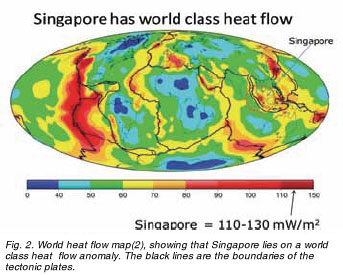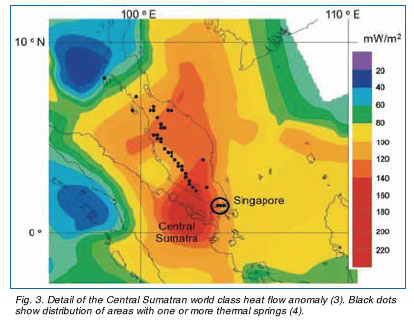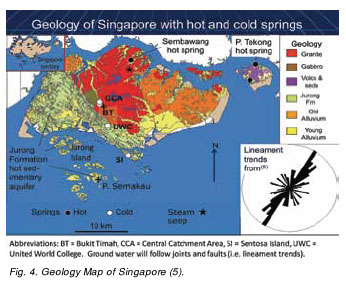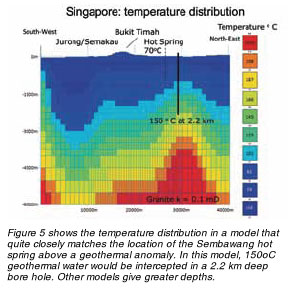|
by Grahame Oliver, Andrew Palmer, Hendrik Tjiawi and Faizal Zulkefli
 he cover picture to this article is an artist’s impression of what Singapore was like between 250 and 230 million years ago. Underground chambers of molten granite magma were feeding highly explosive volcanoes on the surface (see article on age dating in this volume of Innovations). The heat flowing through the crust at this time would have been very high. The question is: “is there enough heat flow under present day Singapore to support geothermal power production?" he cover picture to this article is an artist’s impression of what Singapore was like between 250 and 230 million years ago. Underground chambers of molten granite magma were feeding highly explosive volcanoes on the surface (see article on age dating in this volume of Innovations). The heat flowing through the crust at this time would have been very high. The question is: “is there enough heat flow under present day Singapore to support geothermal power production?"
 According to the Geothermal Education Office, over sixty million people obtain their electricity from the heat of recently active volcanoes, especially at the earth’s plate boundaries such as around the Mid Altantic Ridge and the Pacific Ring of Fire. For example geothermal power provides Iceland with 30% and the Philippines with ~25% of its electricity production. Indonesia plans to build 44 new geothermal plants by 2014. Geothermal power is a clean, green, sustainable energy source that can be cheaper than nuclear, wind, solar or natural gas power. For Singapore, geothermal energy looks attractive compared to the uncertainties in natural gas price and availability and the restrictions on wind, wave and solar power alternatives. The disaster in Japan has caused some governments to call a moratorium on nuclear power development. So how can Singapore tap geothermal power? According to the Geothermal Education Office, over sixty million people obtain their electricity from the heat of recently active volcanoes, especially at the earth’s plate boundaries such as around the Mid Altantic Ridge and the Pacific Ring of Fire. For example geothermal power provides Iceland with 30% and the Philippines with ~25% of its electricity production. Indonesia plans to build 44 new geothermal plants by 2014. Geothermal power is a clean, green, sustainable energy source that can be cheaper than nuclear, wind, solar or natural gas power. For Singapore, geothermal energy looks attractive compared to the uncertainties in natural gas price and availability and the restrictions on wind, wave and solar power alternatives. The disaster in Japan has caused some governments to call a moratorium on nuclear power development. So how can Singapore tap geothermal power?
Engineered Geothermal Systems
 In the past 10 years, geoscientists have realised that hot rocks can be found far away from plate boundaries, particularly where granite is found at depth. Granite can be slightly radioactive and over millions of years generate heat that can be trapped under blanketing layers of insulating sedimentary rock. Figure 1 shows how heat is extracted from hot dry rock: bore holes are drilled and cold water is injected to depths where there are hot rocks. The cold water is heated up by the hot rocks and pumped up to the surface in production wells. Fracturing between the injection and production wells can be engineered or enhanced by cracking the rock with very high pressure water, hence these are called engineered (or enhanced) geothermal systems (EGS). Instead of steam driven power plants, the latest technology can use geothermal water with temperatures as low as 73oC to boil low boiling temperature hydrocarbon liquids to make vapour which drives turbines to generate electricity. The vapour is then cooled back to liquid and recycled. Meanwhile the waste geothermal water is recycled down injection wells to the hot rocks below. Thus there are two cycles and therefore these are called binary power plants. Another prospect for geothermal power is hot sedimentary aquifers (HSA): i.e. porous, permeable, hot, sedimentary layers lying on top of and heated by hot dry granites (see Fig. 1). EGS and/or HSA have been explored for or demonstrated in France, Australia, Japan, Germany, the U.K. the U.S. and Switzerland. Commercial EGS/HSA’s are presently being developed in Spain, Australia and the U.S. In the past 10 years, geoscientists have realised that hot rocks can be found far away from plate boundaries, particularly where granite is found at depth. Granite can be slightly radioactive and over millions of years generate heat that can be trapped under blanketing layers of insulating sedimentary rock. Figure 1 shows how heat is extracted from hot dry rock: bore holes are drilled and cold water is injected to depths where there are hot rocks. The cold water is heated up by the hot rocks and pumped up to the surface in production wells. Fracturing between the injection and production wells can be engineered or enhanced by cracking the rock with very high pressure water, hence these are called engineered (or enhanced) geothermal systems (EGS). Instead of steam driven power plants, the latest technology can use geothermal water with temperatures as low as 73oC to boil low boiling temperature hydrocarbon liquids to make vapour which drives turbines to generate electricity. The vapour is then cooled back to liquid and recycled. Meanwhile the waste geothermal water is recycled down injection wells to the hot rocks below. Thus there are two cycles and therefore these are called binary power plants. Another prospect for geothermal power is hot sedimentary aquifers (HSA): i.e. porous, permeable, hot, sedimentary layers lying on top of and heated by hot dry granites (see Fig. 1). EGS and/or HSA have been explored for or demonstrated in France, Australia, Japan, Germany, the U.K. the U.S. and Switzerland. Commercial EGS/HSA’s are presently being developed in Spain, Australia and the U.S.
Singapore has world class heat flow
 Heat flow measurements from oil wells in neighbouring Sumatra and Malaysia show that Singapore is situated on a world class heat flow anomaly (see Fig. 2). Evidence for this high heat flow is seen in the > 60 hot springs in the granite terrains of the Malaysian Peninsular including three in Singapore (see Fig. 3). Heat flow measurements from oil wells in neighbouring Sumatra and Malaysia show that Singapore is situated on a world class heat flow anomaly (see Fig. 2). Evidence for this high heat flow is seen in the > 60 hot springs in the granite terrains of the Malaysian Peninsular including three in Singapore (see Fig. 3).
Figure 4 illustrates the geology of Singapore and the location of ~70oC hot and cold (26oC) springs. Granite and gabbro (250 to 230 million years old) in the centre is intruded into contemporary volcanics and sediments in the east (e.g. on Pulau Tekong) and partially buried under a cover of Jurong Formation (~200 million years old) composed of continental red beds and shallow marine sediments to the south-west. A ~150 m thick layer of 1 -2 million year old Old Alluvium of sand and gravel overlies the granite in the east and north-west. Younger recent alluvium fills the lower valleys. Thus there are no recent volcanoes on Singapore that can explain the present day high heat flow. We calculate that about half the heat comes from the granite, the rest must come from an anomaly in the mantle.
 The hot springs in Singapore have been studied before(5), (6). They appear to be related to faults in the Bukit Timah Granite or its volcanic equivalent on Pulau Tekong. The concentration of Na2+, K+, Mg2+ and Ca2+ dissolved in the 70oC Sembawang hot spring water depends on the temperature of the geothermal reservoir. We calculate that the reservoir water is ~160oC, i.e. hot enough to drive binary power generators. The hot spring on the north coast of Pulau Tekong is also ~70oC but is contaminated with sea water. The hot spring reported on the SW side of Pulau Tekong has been lost under land-fill. The hot springs in Singapore have been studied before(5), (6). They appear to be related to faults in the Bukit Timah Granite or its volcanic equivalent on Pulau Tekong. The concentration of Na2+, K+, Mg2+ and Ca2+ dissolved in the 70oC Sembawang hot spring water depends on the temperature of the geothermal reservoir. We calculate that the reservoir water is ~160oC, i.e. hot enough to drive binary power generators. The hot spring on the north coast of Pulau Tekong is also ~70oC but is contaminated with sea water. The hot spring reported on the SW side of Pulau Tekong has been lost under land-fill.
Ground water model for Singapore
We have run Auckland University TOUGH-2 (Transport Of Unsaturated Groundwater and Heat) computer models for Singapore based on the theory that cold rain water falling on the Central Catchment forms a fresh water lens under Singapore which heats up due to the high heat flow. Several models were run with varying permeabilities, heat flows and radiogenic heat productions.
 Figure 5 shows the temperature distribution in a model that quite closely matches the location of the Sembawang hot spring above a geothermal anomaly. In this model, 150oC geothermal water would be intercepted in a 2.2 km deep bore hole. Other models give greater depths. Figure 5 shows the temperature distribution in a model that quite closely matches the location of the Sembawang hot spring above a geothermal anomaly. In this model, 150oC geothermal water would be intercepted in a 2.2 km deep bore hole. Other models give greater depths.
Uses for geothermal power
In Singapore, geothermal energy could be used for electricity generation, desalination, or district cooling depending on the water temperature. One innovative possibility for Singapore is to use the energy directly for district cooling (i.e. air conditioning) in new build urban housing estates or new industrial complexes. There is no need to generate electricity first and then use it to drive conventional air conditioners. Instead, a more efficient option is for the geothermal hot water to drive an adsorption chiller system working on the same principle as an adsorption refrigerator, which has no moving parts and so is low-maintenance and noise-free.
We have carried out a cost benefit exercise for a new housing estate of 6,000 households: assuming a 90oC geothermal resource at 1.8 km depth, running for 8 hours a day for 30 years, the fixed and operating costs would be between SGD 60 and 40 million depending on the drilling costs. These options would be 44 - 33% cheaper than conventional one room air conditioning using electricity
Feasibility study
The essential next step towards proof of concept is to drill an exploration borehole. Ideally 300 m deep and cored, geothermal exploration bore-holes should be drilled into the three Singapore prospects which will provide data which will allow us to calculate the heat flow, geothermal gradient, potential geothermal heat reserves and potential water flow rates. If the 300 m deep bore-holes show encouraging results we would propose a deeper exploration bore-hole down to 2 km.
Conclusion
Singapore is apparently situated on a world class heat flow anomaly: 70oC hot springs in Singapore support this. Singapore might have an important natural resource in geothermal energy. An innovative use of this geothermal energy might in district cooling schemes. A feasibility study is required.
Acknowledgements
We wish to record our gratitude to the Ministry of Education who funded ACrf Tier 1 Grant R-264-000-275-133.
 Click here to download the full issue for USD 6.50 Click here to download the full issue for USD 6.50
|


 he cover picture to this article is an artist’s impression of what Singapore was like between 250 and 230 million years ago. Underground chambers of molten granite magma were feeding highly explosive volcanoes on the surface (see article on age dating in this volume of Innovations). The heat flowing through the crust at this time would have been very high. The question is: “is there enough heat flow under present day Singapore to support geothermal power production?"
he cover picture to this article is an artist’s impression of what Singapore was like between 250 and 230 million years ago. Underground chambers of molten granite magma were feeding highly explosive volcanoes on the surface (see article on age dating in this volume of Innovations). The heat flowing through the crust at this time would have been very high. The question is: “is there enough heat flow under present day Singapore to support geothermal power production?" According to the Geothermal Education Office, over sixty million people obtain their electricity from the heat of recently active volcanoes, especially at the earth’s plate boundaries such as around the Mid Altantic Ridge and the Pacific Ring of Fire. For example geothermal power provides Iceland with 30% and the Philippines with ~25% of its electricity production. Indonesia plans to build 44 new geothermal plants by 2014. Geothermal power is a clean, green, sustainable energy source that can be cheaper than nuclear, wind, solar or natural gas power. For Singapore, geothermal energy looks attractive compared to the uncertainties in natural gas price and availability and the restrictions on wind, wave and solar power alternatives. The disaster in Japan has caused some governments to call a moratorium on nuclear power development. So how can Singapore tap geothermal power?
According to the Geothermal Education Office, over sixty million people obtain their electricity from the heat of recently active volcanoes, especially at the earth’s plate boundaries such as around the Mid Altantic Ridge and the Pacific Ring of Fire. For example geothermal power provides Iceland with 30% and the Philippines with ~25% of its electricity production. Indonesia plans to build 44 new geothermal plants by 2014. Geothermal power is a clean, green, sustainable energy source that can be cheaper than nuclear, wind, solar or natural gas power. For Singapore, geothermal energy looks attractive compared to the uncertainties in natural gas price and availability and the restrictions on wind, wave and solar power alternatives. The disaster in Japan has caused some governments to call a moratorium on nuclear power development. So how can Singapore tap geothermal power?
 In the past 10 years, geoscientists have realised that hot rocks can be found far away from plate boundaries, particularly where granite is found at depth. Granite can be slightly radioactive and over millions of years generate heat that can be trapped under blanketing layers of insulating sedimentary rock. Figure 1 shows how heat is extracted from hot dry rock: bore holes are drilled and cold water is injected to depths where there are hot rocks. The cold water is heated up by the hot rocks and pumped up to the surface in production wells. Fracturing between the injection and production wells can be engineered or enhanced by cracking the rock with very high pressure water, hence these are called engineered (or enhanced) geothermal systems (EGS). Instead of steam driven power plants, the latest technology can use geothermal water with temperatures as low as 73oC to boil low boiling temperature hydrocarbon liquids to make vapour which drives turbines to generate electricity. The vapour is then cooled back to liquid and recycled. Meanwhile the waste geothermal water is recycled down injection wells to the hot rocks below. Thus there are two cycles and therefore these are called binary power plants. Another prospect for geothermal power is hot sedimentary aquifers (HSA): i.e. porous, permeable, hot, sedimentary layers lying on top of and heated by hot dry granites (see Fig. 1). EGS and/or HSA have been explored for or demonstrated in France, Australia, Japan, Germany, the U.K. the U.S. and Switzerland. Commercial EGS/HSA’s are presently being developed in Spain, Australia and the U.S.
In the past 10 years, geoscientists have realised that hot rocks can be found far away from plate boundaries, particularly where granite is found at depth. Granite can be slightly radioactive and over millions of years generate heat that can be trapped under blanketing layers of insulating sedimentary rock. Figure 1 shows how heat is extracted from hot dry rock: bore holes are drilled and cold water is injected to depths where there are hot rocks. The cold water is heated up by the hot rocks and pumped up to the surface in production wells. Fracturing between the injection and production wells can be engineered or enhanced by cracking the rock with very high pressure water, hence these are called engineered (or enhanced) geothermal systems (EGS). Instead of steam driven power plants, the latest technology can use geothermal water with temperatures as low as 73oC to boil low boiling temperature hydrocarbon liquids to make vapour which drives turbines to generate electricity. The vapour is then cooled back to liquid and recycled. Meanwhile the waste geothermal water is recycled down injection wells to the hot rocks below. Thus there are two cycles and therefore these are called binary power plants. Another prospect for geothermal power is hot sedimentary aquifers (HSA): i.e. porous, permeable, hot, sedimentary layers lying on top of and heated by hot dry granites (see Fig. 1). EGS and/or HSA have been explored for or demonstrated in France, Australia, Japan, Germany, the U.K. the U.S. and Switzerland. Commercial EGS/HSA’s are presently being developed in Spain, Australia and the U.S.
 Heat flow measurements from oil wells in neighbouring Sumatra and Malaysia show that Singapore is situated on a world class heat flow anomaly (see Fig. 2). Evidence for this high heat flow is seen in the > 60 hot springs in the granite terrains of the Malaysian Peninsular including three in Singapore (see Fig. 3).
Heat flow measurements from oil wells in neighbouring Sumatra and Malaysia show that Singapore is situated on a world class heat flow anomaly (see Fig. 2). Evidence for this high heat flow is seen in the > 60 hot springs in the granite terrains of the Malaysian Peninsular including three in Singapore (see Fig. 3).
 The hot springs in Singapore have been studied before(5), (6). They appear to be related to faults in the Bukit Timah Granite or its volcanic equivalent on Pulau Tekong. The concentration of Na2+, K+, Mg2+ and Ca2+ dissolved in the 70oC Sembawang hot spring water depends on the temperature of the geothermal reservoir. We calculate that the reservoir water is ~160oC, i.e. hot enough to drive binary power generators. The hot spring on the north coast of Pulau Tekong is also ~70oC but is contaminated with sea water. The hot spring reported on the SW side of Pulau Tekong has been lost under land-fill.
The hot springs in Singapore have been studied before(5), (6). They appear to be related to faults in the Bukit Timah Granite or its volcanic equivalent on Pulau Tekong. The concentration of Na2+, K+, Mg2+ and Ca2+ dissolved in the 70oC Sembawang hot spring water depends on the temperature of the geothermal reservoir. We calculate that the reservoir water is ~160oC, i.e. hot enough to drive binary power generators. The hot spring on the north coast of Pulau Tekong is also ~70oC but is contaminated with sea water. The hot spring reported on the SW side of Pulau Tekong has been lost under land-fill.
 Figure 5 shows the temperature distribution in a model that quite closely matches the location of the Sembawang hot spring above a geothermal anomaly. In this model, 150oC geothermal water would be intercepted in a 2.2 km deep bore hole. Other models give greater depths.
Figure 5 shows the temperature distribution in a model that quite closely matches the location of the Sembawang hot spring above a geothermal anomaly. In this model, 150oC geothermal water would be intercepted in a 2.2 km deep bore hole. Other models give greater depths.
 Click here to download the full issue for USD 6.50
Click here to download the full issue for USD 6.50